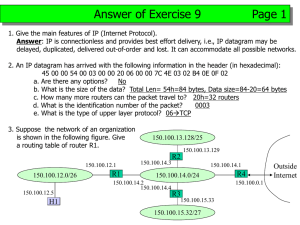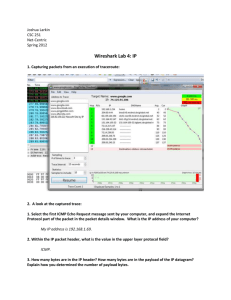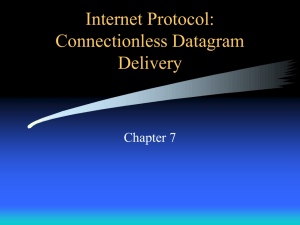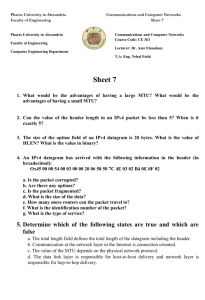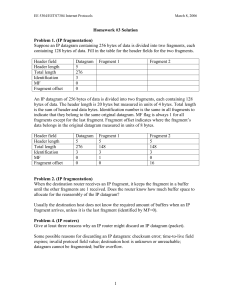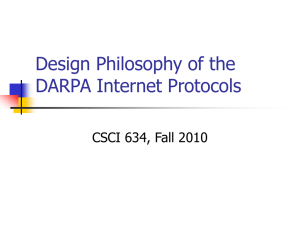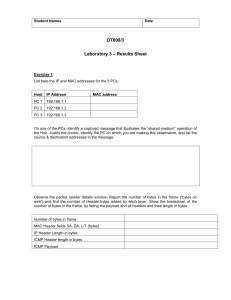Internet Protocol
advertisement
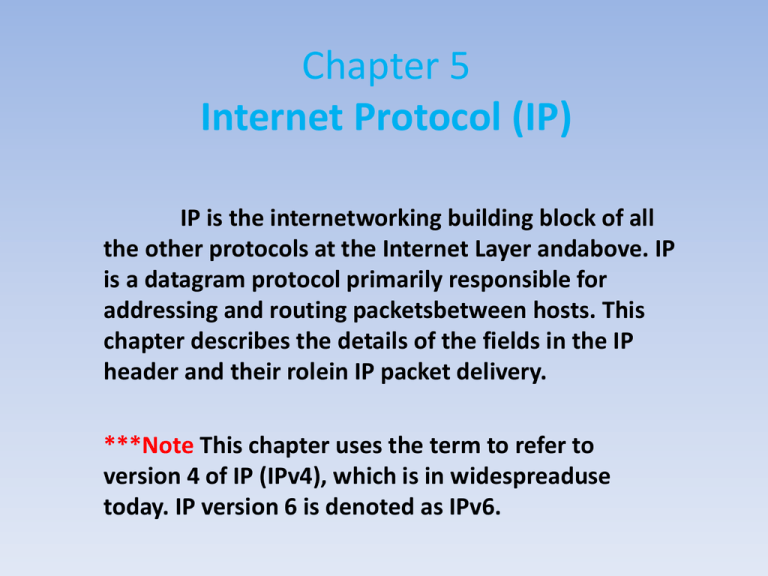
Chapter 5 Internet Protocol (IP) IP is the internetworking building block of all the other protocols at the Internet Layer andabove. IP is a datagram protocol primarily responsible for addressing and routing packetsbetween hosts. This chapter describes the details of the fields in the IP header and their rolein IP packet delivery. ***Note This chapter uses the term to refer to version 4 of IP (IPv4), which is in widespreaduse today. IP version 6 is denoted as IPv6. Introduction to IP IP is the primary protocol for the Internet Layer of the Department of Defense (DoD) Advanced Research Projects Agency (DARPA) model and provides the internetworking functionality that makes large-scale internetworks such as the Internet possible. IP has lasted since it was formalized in 1981 with RFC 791 and will continue to be used on the Internet for years to come. Only relatively recently have IP’s shortcomings been addressed in a new version known as IPv6. For more information about IPv6, see Chapter 8, “Internet Protocol Version 6 (IPv6).” IP’s amazing longevity is a tribute to its original design. IP Services IP offers the following services to upper layer protocols: ■ Internetworking protocol ■ Multiple client protocols ■ Datagram delivery ■ Independence from Network Interface Layer At the Internet Layer ■ Fragmentation and reassembly To support the maximum frame sizes of different Network Interface Layer technologies ■ Extensible through IP options When features are required that are not available using the standard IP header ■ Datagram packet-switching technology IP MTU ตาราง 5-1 IP MTUs for Common Network Interface Layer Technologies Network Interface Layer Technology IP MTU Ethernet (Ethernet II encapsulation) 1500 Ethernet (IEEE 802.3 Sub-Network Access Protocol [SNAP] encapsulation) 1492 Token Ring (4 and 16 Mbps) Varies based on token holding time Fiber Distributed Data Interface (FDDI) Frame relay 4352 1592 (with a 2-byte Address field in the Frame Relay header) The IP Datagram รู ปที่ 5-1 โครงสร้ างของ IP datagram Network Interface layer The IP Header Figure 5-2 shows the IP header’s structure. The following sections discuss the fields of the IP header. Figure 5-2 The structure of the IP header Version The Version field is 4 bits long and is used to indicate the IP header version. A 4-bit field can have values from 0 through 15. The most prevalent IP version used today on organization intranets and the Internet is version 4, sometimes referred to as IPv4. The next version of IP is IPv6. All other values for the Version field are either undefined or not in use. For the latest list of the defined values of the IP Version field, see http://www.iana.org/assignments/version-numbers. Internet Header Length The Internet Header Length (IHL) field is 4 bits long and is used to indicate the IP header size. The maximum number that can be represented with 4 bits is 15. Therefore, the IHL field cannot possibly be a byte counter. Rather, the IHL field indicates the number of 32-bit words (4-byte blocks) in the IP header. The typical IP header does not contain any options and is 20bytes long. The smallest possible IHL value is 5 (0x5). With the maximum amount of IPoptions, the largest IP header can be 60 bytes long, indicated with a IHL value of 15 (0xF). Using a 4-byte block counter to indicate the IP header size means that the IP header size must always be a multiple of 4. If a set of IP options extend the IP header, they must do so in 4-byte increments. If the set of IP options is not a multiple of 4 bytes long, option padding bytes must be used so that the IP header an each option is always on a 4-byte boundary. Type Of Service Figure 5-3 The structure of the RFC 791 IP Type Of Service field Precedence The Precedence field is 3 bits long and is used to indicate the importance of the datagram. Table 5-2 lists the defined values of the Precedence field. Precedence Value Precedence 000 Routine 001 Priority 010 Immediate 011 Flash 100 Flash Override 101 CRITIC/ECP 110 Internetwork Control 111 Network Control The Precedence field is set to 000 (Routine) by default. Delay The Delay field is a flag indicating either Normal Delay (when set to 0) or Low Delay (when set to 1). If Delay is set to 1, the IP router forwards the IP datagram along the path that has the lowest delay characteristics. An application can request the low delay path when sending either time-sensitive data, such as digitized voice or video, or interactive traffic, such as Telnet sessions. Based on the Delay flag, the router might choose the lower delay terrestrial wide area network (WAN) link over the higher delay satellite link, even if the satellite link has a higher bandwidth. Throughput The Throughput field is a flag indicating either Normal Throughput (when set to 0) or High Throughput (when set to 1). If the Throughput field is set to 1, the IP router forwards the IP datagram along the path that has the highest throughput characteristics. An application can request the high throughput path when sending bulk data. Based on the Throughput flag, the router can choose the higher throughput satellite link over the lower throughput terrestrial WAN link, even if the terrestrial link has a lower delay. Reliability The Reliability field is a flag indicating either Normal Reliability (when set to 0) or High Reliability(when set to 1). During periods of congestion at an IP router, the Reliability field is used to decide which IP datagrams to discard first. If the Reliability field is set to 1, the IP routerdiscards these datagrams last. An application can request the high reliability path when sending time-sensitive data, so that it cannot be discarded. For example, with some methods of sending digital video, the digitized video is sent as two types of packets: The primary type is used to reconstruct the basic video image, and a secondary type is used to provide a higher resolution image. In this case, the primary packets are sent with the Reliability field set to 1 and the secondary packets are sent with the Reliability field set to 0. If congestion occurs at the router, the router discards the secondary packets first. Cost The Cost field is a flag indicating either Normal Cost (when set to 0) or Low Cost (when set to 1), where cost indicates monetary cost. If the Cost field is set to 1, the IP router forwards the IP datagram along the path that has the lowest cost characteristics. An application can request the low cost path when sending noncritical data. Based on the Cost flag, the router can choose a lower cost terrestrial link over a higher cost satellite link, even if the terrestrial link has a lower bandwidth. Reserved The Reserved field is the last bit and must be set to 0. Routers ignore this field when forwarding IP datagrams. RFC 2474 Definition of the TOS Field Figure 5-4 The structure of the RFC 2474 IP TOS field Explicit Congestion Notification and the TOS Field designers of TCP/IP created a new set of standards for both hosts and routers. These standards describe active queue management (AQM) on IP routers (RFC 2309) to allow the router to monitor that state of its forwarding queues and provide a mechanism to enable routers to report to sending hosts that congestion is occurring, allowing the sending hosts to lower their transmission rate before the router begins dropping packets. The router reporting and host response mechanism is known as Explicit Congestion Notification (ECN) and is defined in RFC 3168. ECN support in IP uses the two unused bits of the RFC 2474-defined TOS field. Figure 5-5 shows the new definition of the TOS field with ECN. Figure 5-5 The structure of the RFC 3168 IP TOS field The two unused bits in the RFC 2474-defined TOS field are defined in RFC 3168 as the ECN field, which has the following values: ■ 00 The sending host does not support ECN. ■ 01 or 10 The sending host supports ECN. ■ 11 Congestion has been experienced by a router. Total Length As Figure 5-2 shows, the Total Length field is 2 bytes long and is used to indicate the size of the IP datagram (IP header and IP payload) in bytes. With 16 bits, the maximum total length that can be indicated is 65,535 bytes. For typical maximum-sized IP datagrams, the total length is the same as the IP MTU for that Network Interface Layer technology. Between the header length and the total length, the IP payload length can be determined from the following formula: IP payload length (bytes) = Total Length value (bytes) – (4 × IHL value (32bit words)) Identification The Identification field is 2 bytes long and is used to identify a specific IP packet sent between a source and destination node. The sending host sets the field’s value, and the field is incremented for successive IP datagrams. The Identification field is used to identify the fragments of an original IP datagram. Flags The Flags field is 3 bits long and contains two flags for fragmentation. One flag is used to indicate whether the IP payload is eligible for fragmentation, and the other indicates whether or not there are more fragments to follow for this fragmented IP datagram. More information on these flags and their uses can be found in the section titled “Fragmentation,” later in this chapter. Fragment Offset The Fragment Offset field is 13 bits long and is used to indicate the offset of where this fragment begins relative to the original unfragmented IP payload. More information on the Fragment Offset field can be found in the section titled “Fragmentation,” later in this chapter. Time-To-Live The Time-To-Live (TTL) field is 1 byte long and is used to indicate how many links on which this IP datagram can travel before an IP router discards it. The TTL field was originally intended for use as a time counter, to indicate the number of seconds that the IP datagram could exist on the Internet. An IP router was intended to keep track of the time that it received the IP datagram and the time that it forwarded the IP datagram. The TTL was then decreased by the number of seconds that the packet resided at the router. However, the latest modern standard (RFC 1812) specifies that IP routers decrement the TTL by 1 when forwarding an IP datagram. Therefore, the TTL is an inverse link count. The sending host sets the initial TTL, which acts as a maximum link count. The maximum value limits the number of links on which the datagram can travel and prevents a datagram from indefinitely looping. Protocol The Protocol field is 1 byte long and is used to indicate the upper layer protocol containedwithin the IP payload. Some common values of the IP Protocol field are 1 for ICMP, 6 for TCP,and 17 (0x11) for UDP. The Protocol field acts as a multiplex identifier so that the payload can be passed to the proper upper layer protocol on receipt at the destination node. Windows Sockets applications can refer to protocols by name. Protocol names are resolved to protocol numbers through the Protocol file stored in the %SystemRoot%\System32 \Drivers\Etc directory. Table 5-3 lists some of the values of the IP Protocol field for protocols that Windows Server 2008 and Windows Vista support. Table 5-3 Values of the IP Protocol Field Value Protocol 1 ICMP 2 IGMP 6 TCP 17 UDP 41 IPv6 47 Generic Routing Encapsulation (GRE) IP security Encapsulating Security Payload (ESP) IP security Authentication Header (AH) 50 51 For a complete list of IP Protocol field values, see http://www.iana.org/assignments/protocol-numbers. Header Checksum The Header Checksum field is 2 bytes long and performs a bit-level integrity check on the IP header only. The IP payload is not included, and IP payloads must include their own checksums to check for bit-level integrity. The sending host performs an initial checksum in the sent IP datagram. Each router in the path between the source and destination verifies the Header Checksum field before processing the packet. If the verification fails, the router silently discards the IP datagram. Because each router in the path between the source and destination decrements the TTL, the header checksum changes at each router. Source Address The Source Address field is 4 bytes long and contains the IP address of the source host, unless a network address translator (NAT) is translating the IP datagram. A NAT is used to translate between public and private addresses when connecting to the Internet. NAT is defined in RFC 1631. Destination Address The Destination Address field is 4 bytes long and contains the IP address of the destination host, unless the IP datagram is being translated by a NAT or being loose-or strict-source routed. More information on IP source routing can be found in the section titled “IP Options,” later in this chapter. Options and Padding Options and padding can be added to the IP header, but must be done in 4-byte increments so that the size of the IP header can be indicated using the Header Length field. For an example of the structure of the IP header, the following is frame 1 of Capture 05-01, a Network Monitor trace that is included in the \Captures folder on the companion CD-ROM, as displayed with Network Monitor 3.1: Fragmentation When a source host or a router must transmit an IP datagram on a link and the MTU of the link is less than the IP datagram’s size, the IP datagram must be fragmented. When IP fragmentation occurs, the IP payload is segmented and each segment is sent with its own IP header. The IP header contains information required to reassemble the original IP payload at the destination host. Because IP is a datagram packet-switching technology and the fragments can arrive in a different order from which they were sent, the fragments must be grouped (using the Identification field), sequenced (using the Fragment Offset field), and delimited (using the More Fragments flag). Fragmentation Fields Figure 5-6 shows the fragmentation fields in the IP header, which are described in the following sections. Figure 5-6 The fields in the IP header used for fragmentation Identification The IP Identification field is used to group all the fragments of the payload of an original IP datagram together. The sending host sets the value of the Identification field, and this value is not changed during the fragmentation process. The Identification field is set even when fragmentation of the IP payload is not allowed by setting the Don’t Fragment (DF) flag. Don’t Fragment Flag The DF flag is set to 0 to allow fragmentation and set to 1 to prohibit fragmentation, so fragmentation occurs only if the DF flag is set to 0. If fragmentation is needed to forward the IP datagram and the DF flag is set to 1, the router should send an ICMP Destination Unreachable-Fragmentation Needed And DF Set message back to the source host and discards the IP datagram. Fragmentation and reassembly is an expensive process at the routers and the destination host. The DF flag and the ICMP Destination UnreachableFragmentation Needed And DF Set message are the mechanisms by which a sending host discovers the MTU of the path between the source and the destination, or Path MTU Discovery. For more information, see Chapter 6,“Internet Control Message Protocol (ICMP).” More Fragments Flag The More Fragments (MF) flag is set to 0 if there are no more fragments that follow this fragment (this is the last fragment), and set to 1 if there are more fragments that follow this fragment (this is not the last fragment). Fragment Offset The Fragment Offset field is set to indicate the position of the fragment relative to the original IP payload. The Fragment Offset is an offset used for sequencing during reassembly, putting the incoming fragments in proper order to reconstruct the original payload. The Fragment Offset field is 13 bits long. With a maximum IP payload size of 65,515 bytes (the maximum IP MTU of 65,535 minus a minimum-sized IP header of 20 bytes), the Fragment Offset field cannot possibly indicate a byte offset. At 13 bits, the maximum value is 8191. The fragment offset must be 16 bits long to be a byte offset. Fragmentation Example As an example of the fragmentation process, a node on a Token Ring network sends a fragmentable IP datagram with the IP Identification field set to 9999 to a node on an Ethernet network, as shown in Figure 5-7. Figure 5-7 An example of a network where IP fragmentation can occur Assuming a 9-ms token holding time, a 4-Mbps ring, and no Token Ring source routing header, the IP MTU for the Token Ring network is 4482 bytes. The Ethernet IP MTU is 1500 bytes using Ethernet II encapsulation. Table 5-4 shows the fields relevant to fragmentation in the IP header and their values for the original IP datagram. Table 5-4 Original IP Datagram Figure 5-8 The IP fragmentation process when fragmenting from a 4482-byte IP MTU link to a 1500-byte IP MTU link Table 5-5 shows the fields relevant to fragmentation in the IP header of the four fragments. Table 5-5 Fragments of the Original IP Datagram Reassembly Example The fragments are forwarded by the intermediate IP router(s) to the destination host. Because IP is a datagram-based packet-switching technology, the fragments can take different paths to the destination and arrive in a different order from which the fragmenting router forwarded them. IP uses the Identification and Source IP Address fields to group the arriving fragments together. After receiving a fragment (not necessarily the first fragment of the original IP payload), an IP implementation can allocate reassembly resources comprised of the following: ■ A data buffer to contain the IP payload (65,515 bytes) ■ A header buffer to contain the IP header (60 bytes) ■ A fragment block bit table (1024 bytes or 8192 bits) ■ A total length data variable ■ A timer Figure 5-9 The IP reassembly process for the four fragments of the original IP datagram Fragmenting a Fragment It is possible for fragments to become further fragmented. In this case, each fragmented payload is fragmented to fit the MTU of the link onto which it is being forwarded. The process of fragmenting a fragmented payload is slightly different from fragmenting an original IP payload in how the MF flag is set. When fragmenting a previously fragmented payload, the MF flag is always set to 1, except when the fragment of the fragmented payload is the last fragment of the original payload. Avoiding Fragmentation Although fragmentation allows IP nodes to communicate regardless of differing MTUs in intermediate subnets and without user intervention, IP fragmentation and reassembly is a relatively expensive process—both at the routers (or sending hosts) and at the destination host. On the modern Internet, fragmentation is highly discouraged; Internet routers are busy enough with the forwarding of IP traffic. Setting the DF Flag with Ping The Windows Server 2008 and Windows Vista Ping.exe tool with the -f option can be used to set the DF flag to 1 in ICMP Echo messages. The syntax is ping –f Destination For example, to ping 10.0.0.1 and set the DF flag to 1, use the following command: ping -f 10.0.0.1 By default, ICMP Echo messages sent by the Ping.exe tool have the DF flag set to 0 (fragmentation allowed). Setting the IP Payload Size with Ping The Windows Server 2008 and Windows Vista Ping.exe tool with the -l option can be used to send IP packets with an arbitrary size by specifying the size of the Optional Data field in an ICMP Echo message. The syntax is: ping -l OptionalDataFieldSize Destination OptionalDataFieldSize is the size of the Optional Data field in an ICMP Echo message in bytes. For example, to ping 10.0.0.1 with an Optional Data field size of 5000, use the following command: ping -l 5000 10.0.0.1 The default Optional Data field size for Ping is 32 bytes. Using Ping to Do Source Fragmentation The Windows Server 2008 and Windows Vista Ping.exe tool with the -l option can be used to do source fragmentation. Pinging with an Optional Data field size that is greater than (IP MTU – 28) bytes produces sourcefragmented packets. For example, pinging from an Ethernet node with an Optional Data field size of 1472 or less does not produce fragmented packets. Pinging from an Ethernet node with an Optional Data field size greater than 1472 does produce fragmented packets. Fragmentation and Translational Bridging Environments Translational bridging is the interconnection of two different Network Interface Layer technologies on the same network by a Layer 2 device such as a bridge or switch. Translational bridges were used to connect an Ethernet segment to a Token Ring segment. In modern networks, switches use translational bridging to connect 10-Mbps or 100-Mbps Ethernet nodes to servers on high-speed ports. Common high-speed port technologies include FDDI, Gigabit Ethernet (GbE), and ATM. Figure 5-10 An MTU problem in a translational bridging environment caused by two FDDI hosts connected to two Ethernet switches Fragmentation and TCP/IP for Windows Server 2008 and Windows Vista TCP/IP for Windows Server 2008 and Windows Vista supports IP fragmentation and reassembly with the following additional behaviors: ■ IP can handle irregular fragments, which overlap either fully or partially, with already received fragments for the same payload. ■ When forwarding fragments, IP can forward the individual fragments separately or hold all of the fragments and then send all of them when the last one arrives. The default behavior is to forward individual fragments. You can change this behavior with the netsh interface ipv4 set global groupforwardedfragments=enabled command. ■ The maximum amount of memory that can be allocated for reassembly for all incoming IP packets is controlled by the netsh interface ipv4 set global reassemblylimit=MemorySize command. You can view the current size of the reassembly buffer with the netsh interface ipv4 show global command. IP Options IP options are additional fields appended to the standard 20byte IP header. Although IP options are not required on each IP header, the ability to process IP option fields is required. IP options are used infrequently and mostly for network testing purposes. The IP options portion size of the IP header varies in length based on the IP options that are being used. The individual IP options also vary in length from a single byte to multiple fourbyte quantities. Recall that the maximum-sized IP header that can be indicated with the Header Length field is 60 bytes. With a standard IP header size of 20 bytes, 40 bytes are left for IP options. The first byte of each IP option has the format shown in Figure 5-11. Figure 5-11 The structure of the first byte in an IP option Copy The Copy field is 1 bit long and is used when a router or a sending host must fragment the IP datagram. When the Copy field is set to 0, the IP option should be copied only into the first fragment. When the Copy field is set to 1, the IP option should be copied into all fragments. Option Class The Option Class field is 2 bits long and is used to indicate the general class of the option. Table 5-6 lists the defined option classes. Table 5-6 Option Classes Strict and Loose Source Routing The IP routing process at IP routers is performed through a comparison of the destination IP address with entries in a local routing table. Each router makes a forwarding decision. However, it is sometimes necessary to specify a path that an IP datagram is to take regardless of the router’s routing table entries. The path is specified before the source host sends the datagram; this is known as source routing. For example, in a multipath IP internetwork (where there is more than one path between IP networks), routers choose the best path based on a lowest cost metric. Once a router determines all of the best paths, the higher cost paths are not used unless the topology of the internetwork changes. To check that higher cost paths contain valid links, you must do source routing. Strict Source Route Option The Strict Source Route option contains the following fields: ■ Option Code Set to 137 (Copy Bit=1, Option Class=0, Option Number=9). ■ Option Length Set by the sending host to the number of bytes in the Strict Source Route option. ■ Next Slot Pointer Set to the byte offset (starting at 1) within the Strict Source Route option for the next router. The Next Slot Pointer field’s minimum value is 4. This field is used also in the same manner as the Record Route option to determine the location of the next IP address slot for recording the route. ■ First IP Address, Second IP Address Set by the sending host for the series of IP addresses for successive router destinations in the strict source route; set also by IP routers to the IP address of the forwarding interface. With a maximum of 40 bytes in the IP options portion of the IP header, there is enough room for a maximum of nine IP addresses. Setting the Strict Source Route Option with Ping The Windows Server 2008 and Windows Vista Ping.exe tool with the -k option can be used to add the Strict Source Route option. The Ping.exe tool with the – k option also can be used toset the IP addresses of successive routers and the final destination in ICMP Echo messages. The syntax is: ping -k FirstHopIPAddress SecondHopIPAddress … Destination For example, to ping 10.0.0.1 through neighboring router interfaces 192.168.1.1 and 192.168.2.1, use the following command: ping -k 192.168.1.1 192.168.2.1 10.0.0.1 Network Monitor Capture 05-04 (in the \Captures folder on the companion CD-ROM) provides an example of Ping.exe tool traffic and the use of the Strict Source Route option. Loose Source Route Option Setting the Loose Source Route Option with Ping The Windows Server 2008 and Windows Vista Ping.exe tool with the -j option can be used to add the Loose Source Route option. Additionally, it is used to set the IP addresses of successiverouters and the final destination in ICMP Echo messages. The syntax is: ping -j FirstHopIPAddress SecondHopIPAddress … Destination IP Router Alert The IP Router Alert option is used to indicate to IP routers that additional processing of the IP datagram is required even when the IP datagram is not addressed to the router. The IP Router Alert option is used for the Resource Reservation Protocol (RSVP), IGMP version 2, and IGMP version 3. For example, when a router receives an IP datagram with the IP Router Alert option, it looks at the IP Protocol field to see if the IP payload requires additional processing before making a forwarding decision. RFC 2113 describes the IP Router Alert option. The IP Router Alert option contains the following fields: ■ Option Code Set to 148 (Copy Bit=1, Option Class=0, Option Number=20). ■ Option Length Set to the fixed length of 4. ■ Value A 2-byte field set to 0. All other values are reserved. The value of 0 indicates that the router must examine the packet. Internet Timestamp The Internet Timestamp option contains the following fields: ■ Option Code Set to 68 (Copy Bit=0, Option Class=2, Option Number=4). ■ Option Length Set by the sending host to the number of bytes in the Internet Timestamp option. ■ Next Slot Pointer Set to the byte offset (starting at 1) within the Internet Timestamp option of the next slot for the recording of the IP address and timestamp. The Next Slot Pointer field’s minimum value is 5. ■ Overflow Set by routers to indicate the number of routers that were unable to record their IP address and timestamp. ■ Flags Set by the sending host to indicate the format of the IP Address/Timestamp slots.When Flags is set to 0, the IP address is omitted. This allows up to nine timestamps to be recorded. When Flags is set to 1, the IP address is recorded, allowing up to four IP address/timestamp pairs to be recorded. The Internet Timestamp option format shown assumes Flags is set to 1. When Flags is set to 3, the sending node specifies the IP Setting the Internet Timestamp Option with Ping The Windows Server 2008 and Windows Vista Ping.exe tool and the -s option can be used to send ICMP Echo messages with the Internet timestamp. The syntax is the following: ping -s Slots Destination For example, to ping the IP address of 10.9.1.1 using Internet timestamps with three slots, use the following command: ping -s 3 10.9.1.1 Network Monitor Capture 05-06 (in the \Captures folder on the companion CDROM) provides an example of Ping.exe tool traffic and the use of the Internet Timestamp option. Summary IP provides the internetworking building block for all other Internet Layer and higher protocols in the TCP/IP suite. IP provides a best effort, unreliable, connectionless datagram delivery service between networks of an IP internetwork. The IP header provides addressing, type of delivery, maximum link count, fragmentation, and checksum services. IP fragmentation provides a way for IP datagrams to travel over links with a lower IP MTU than the original IP datagram. The basic services of the IP header are extended through IP options, the most common of which provide source routing, path recording, router alert, and timestamping functions. Chapter 5 INTERNET PROTOCOL(IP) ผูจ้ ดั ทำ 1. นำย เพชร งอนสวรรค์ รหัส 115130462001-6 กลุ่ม 51346CPE 2. นำย กิตติกร สุ ขจันทร์ รหัส 1151304620 กลุ่ม 51346CPE

